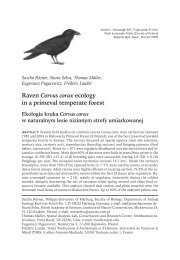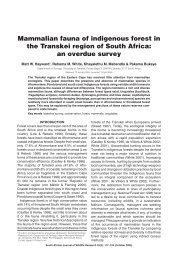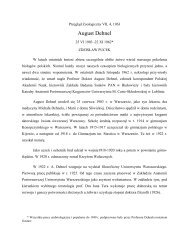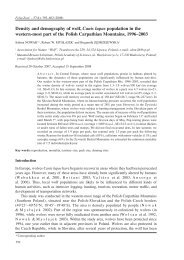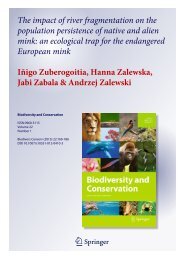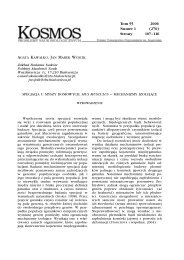Selection of den, rendezvous, and resting sites by wolves in the ...
Selection of den, rendezvous, and resting sites by wolves in the ...
Selection of den, rendezvous, and resting sites by wolves in the ...
Create successful ePaper yourself
Turn your PDF publications into a flip-book with our unique Google optimized e-Paper software.
Introduction<br />
NOTE<br />
<strong>Selection</strong> <strong>of</strong> <strong>den</strong>, <strong>rendezvous</strong>, <strong>and</strong> <strong>rest<strong>in</strong>g</strong> <strong>sites</strong> <strong>by</strong><br />
<strong>wolves</strong> <strong>in</strong> <strong>the</strong> Bialowieza Forest, Pol<strong>and</strong><br />
Jörn Theuerkauf, Sophie Rouys, <strong>and</strong> Wlodzimierz Jedrzejewski<br />
Abstract: We studied wolf (Canis lupus) selection <strong>of</strong> 19 <strong>den</strong>, 10 <strong>rendezvous</strong>, <strong>and</strong> 31 <strong>rest<strong>in</strong>g</strong> <strong>sites</strong> found between 1986<br />
<strong>and</strong> 2000 <strong>in</strong> <strong>the</strong> Bia�owie�a Forest (Pol<strong>and</strong>). Our objective was to determ<strong>in</strong>e whe<strong>the</strong>r <strong>wolves</strong> selected <strong>sites</strong> far from villages,<br />
forest edges, <strong>and</strong> roads, <strong>and</strong> whe<strong>the</strong>r <strong>the</strong>se <strong>sites</strong> had <strong>den</strong>se ground cover for concealment. We also tested whe<strong>the</strong>r<br />
<strong>wolves</strong> selected a particular forest type for <strong>the</strong>ir <strong>den</strong> <strong>sites</strong>. Den <strong>and</strong> <strong>rendezvous</strong> <strong>sites</strong> were located at greater distances<br />
from villages, forest edges, <strong>and</strong> <strong>in</strong>tensively used roads than r<strong>and</strong>om po<strong>in</strong>ts. Locations <strong>of</strong> <strong>rest<strong>in</strong>g</strong> <strong>sites</strong> were not affected<br />
<strong>by</strong> <strong>the</strong>se manmade structures. Wolves selected dry coniferous forests for <strong>den</strong> <strong>sites</strong> but also used o<strong>the</strong>r forest types. We<br />
concluded that <strong>the</strong> suitability <strong>of</strong> an area for pup rais<strong>in</strong>g depended ma<strong>in</strong>ly on <strong>the</strong> spatial distribution <strong>of</strong> forest, human<br />
settlements, <strong>and</strong> public roads, <strong>and</strong> to a lesser extent on habitat characteristics.<br />
Résumé : Nous avons étudié la sélection par des loups (Canis lupus) de 19 antres, 10 lieux de rendez-vous et 31<br />
po<strong>in</strong>ts de repos trouvés entre 1986 et 2000 dans la forêt de Bia�owie�a (Pologne). Notre but était de déterm<strong>in</strong>er si les<br />
loups sélectionnent des <strong>sites</strong> éloignés des villages, de l’orée de la forêt et des routes ou des <strong>sites</strong> où la végétation au<br />
sol est <strong>den</strong>se et leur permet de se dissimuler. Nous avons aussi vérifié si, pour établir leurs antres, les loups sélectionnent<br />
un type particulier de forêt. Les antres et les lieux de rendez-vous se situent plus lo<strong>in</strong> des villages, de l’orée de la<br />
forêt et des routes à forte circulation que des po<strong>in</strong>ts aléatoires. L’emplacement des po<strong>in</strong>ts de repos n’est pas affecté par<br />
les structures d’orig<strong>in</strong>e huma<strong>in</strong>e. Les loups établissent leurs antres dans les forêts de conifères sèches, mais ils utilisent<br />
aussi d’autres types de forêt. Nous avons conclu que les facteurs qui affectent la sélection de l’environnement chez les<br />
loups durant l’élevage des jeunes sont pr<strong>in</strong>cipalement la répartition des forêts, celle des habitations et celle des routes<br />
publiques, alors que l’habitat joue un rôle secondaire.<br />
Wolves (Canis lupus) <strong>in</strong> Europe <strong>and</strong> North America are<br />
recoloniz<strong>in</strong>g areas from which <strong>the</strong>y had been extirpated (Mech<br />
1995; Boitani 2000). The success <strong>of</strong> <strong>the</strong>ir recovery depends<br />
as much on public acceptance as on habitat suitability, which<br />
should provide adequate food resources as well as areas <strong>of</strong><br />
low human activity where <strong>wolves</strong> can retire (Boitani 2000).<br />
The ability to predict potential <strong>den</strong> <strong>and</strong> <strong>rendezvous</strong> <strong>sites</strong> is<br />
necessary to protect <strong>the</strong>se areas dur<strong>in</strong>g <strong>the</strong> breed<strong>in</strong>g season<br />
(Wiscons<strong>in</strong> Wolf Advisory Committee 1999). Although <strong>the</strong>re<br />
Theuerkauf et al. 167<br />
are studies on <strong>den</strong> <strong>and</strong> <strong>rendezvous</strong> <strong>sites</strong> from North America<br />
(Murie 1944; Ballard <strong>and</strong> Dau 1983; Fuller 1988; Ciucci <strong>and</strong><br />
Mech 1992) <strong>and</strong> Russia (Tehs<strong>in</strong> 1987; Ryabov 1988), <strong>the</strong>re<br />
is a lack <strong>of</strong> data on <strong>the</strong> habitat selection <strong>of</strong> <strong>den</strong>n<strong>in</strong>g <strong>wolves</strong><br />
as well as on <strong>the</strong> potential <strong>in</strong>fluence <strong>of</strong> humans on <strong>den</strong>, <strong>rendezvous</strong>,<br />
<strong>and</strong> <strong>rest<strong>in</strong>g</strong> site selection. We tested whe<strong>the</strong>r<br />
<strong>wolves</strong> <strong>of</strong> <strong>the</strong> Bia�owie�a Forest (Pol<strong>and</strong>) selected <strong>den</strong>, <strong>rendezvous</strong>,<br />
<strong>and</strong> <strong>rest<strong>in</strong>g</strong> <strong>sites</strong> that were far<strong>the</strong>r from villages, forest<br />
edges, <strong>and</strong> roads than r<strong>and</strong>om <strong>and</strong> had a <strong>den</strong>se ground<br />
cover <strong>of</strong>fer<strong>in</strong>g concealment. We also assessed which forest<br />
type <strong>wolves</strong> selected for <strong>den</strong> <strong>sites</strong>.<br />
Received 1 May 2002. Accepted 16 October 2002. Published on <strong>the</strong> NRC Research Press Web site at http://cjz.nrc.ca on<br />
21 February 2003.<br />
J. Theuerkauf. 1,2,3 Mammal Research Institute, Polish Academy <strong>of</strong> Sciences, 17-230 Bia�owie�a, Pol<strong>and</strong>, <strong>and</strong> Wildlife Biology <strong>and</strong><br />
Management Unit, Department <strong>of</strong> Ecosystem <strong>and</strong> L<strong>and</strong>scape Management, Munich University <strong>of</strong> Technical Sciences, 85354<br />
Freis<strong>in</strong>g, Germany.<br />
S. Rouys. 3 Mammal Research Institute, Polish Academy <strong>of</strong> Sciences, 17-230 Bia�owie�a, Pol<strong>and</strong>, <strong>and</strong> Wildlife Management<br />
Department, Sparsholt College, Hampshire, SO21 2NF, U.K.<br />
W. J�drzejewski. Mammal Research Institute, Polish Academy <strong>of</strong> Sciences, 17-230 Bia�owie�a, Pol<strong>and</strong>.<br />
1 Correspond<strong>in</strong>g author (e-mail: Theuerkauf@wp.pl).<br />
2 Address for correspon<strong>den</strong>ce: B.P. 2549, 98846 Nouméa CEDEX, New Caledonia.<br />
3 Present address: International Centre for Ecology, Polish Academy <strong>of</strong> Sciences, Be�zka 24, 38-700 Ustrzyki Dolne, Pol<strong>and</strong>.<br />
Can. J. Zool. 81: 163–167 (2003) doi: 10.1139/Z02-190 © 2003 NRC Canada<br />
163
164 Can. J. Zool. Vol. 81, 2003<br />
Fig. 1. Locations <strong>of</strong> <strong>den</strong> (black dots circled <strong>in</strong> white) <strong>and</strong> <strong>rendezvous</strong><br />
(white dots) <strong>sites</strong> <strong>of</strong> four wolf (Canis lupus) packs <strong>in</strong><br />
<strong>the</strong> Bia�owie�a Forest with distribution <strong>of</strong> <strong>the</strong> commercial forest<br />
(light grey), nature reserves <strong>and</strong> Belarussian National Park (medium<br />
grey), <strong>the</strong> strict reserve <strong>of</strong> <strong>the</strong> Polish Bia�owie�a National<br />
Park (dark grey), human settlements (black), heavily used public<br />
roads (double l<strong>in</strong>es), forest roads (dotted l<strong>in</strong>es), <strong>and</strong> state border<br />
between Pol<strong>and</strong> <strong>and</strong> Belarus (broken l<strong>in</strong>e).<br />
Study area <strong>and</strong> methods<br />
The study area was <strong>the</strong> Polish part <strong>of</strong> <strong>the</strong> Bia�owie�a Forest<br />
(580 km 2 ), which is situated on <strong>the</strong> border with Belarus.<br />
A 100 km 2 section <strong>of</strong> <strong>the</strong> forest is protected as <strong>the</strong> Bia�owie�a<br />
National Park (Fig. 1) with a strictly protected core area <strong>of</strong><br />
50 km 2 <strong>in</strong> which harvest<strong>in</strong>g <strong>of</strong> plants or animals is prohibited,<br />
entry is limited to permit holders, <strong>and</strong> no motorized<br />
traffic is allowed. There are 22 additional small (0.1–3.7 km 2 )<br />
nature reserves <strong>in</strong> <strong>the</strong> Bia�owie�a Forest. Human activity <strong>in</strong><br />
<strong>the</strong> strict reserve <strong>of</strong> <strong>the</strong> National Park is low except for a<br />
small area close to <strong>the</strong> park’s entrance where tourists are<br />
given guided tours. Human activity is more <strong>in</strong>tense <strong>in</strong> <strong>the</strong><br />
rest <strong>of</strong> <strong>the</strong> forest, which is exploited commercially. Human<br />
<strong>den</strong>sity is about 7 <strong>in</strong>habitants/km 2 <strong>in</strong> <strong>the</strong> Bia�owie�a Forest<br />
<strong>and</strong> 70 <strong>in</strong>habitants/km 2 <strong>in</strong> <strong>the</strong> Bia�ystok adm<strong>in</strong>istration district<br />
surround<strong>in</strong>g <strong>the</strong> study area. The <strong>den</strong>sity <strong>of</strong> forest roads<br />
suitable for two-wheel-drive vehicles is about 1.2 km/km 2 <strong>in</strong><br />
<strong>the</strong> commercial forest, but only about 50 km <strong>of</strong> paved roads<br />
(0.1 km/km 2 ) is <strong>in</strong>tensively used <strong>by</strong> <strong>the</strong> public. The Belarussian<br />
part <strong>of</strong> <strong>the</strong> Bia�owie�a Forest (870 km 2 ), which is adjacent to<br />
<strong>the</strong> study area, is a national park, but limited logg<strong>in</strong>g is allowed<br />
<strong>and</strong> <strong>wolves</strong> are hunted (J�drzejewska et al. 1996).<br />
Wolves have been protected s<strong>in</strong>ce 1989 <strong>in</strong> <strong>the</strong> Polish part <strong>of</strong><br />
<strong>the</strong> Bia�owie�a Forest, but some <strong>wolves</strong> from <strong>the</strong> commercial<br />
forest <strong>and</strong> national park died <strong>in</strong> snares set <strong>by</strong> poachers<br />
for wild boar (Sus scr<strong>of</strong>a) or were shot. In <strong>the</strong> study area, <strong>the</strong><br />
core area <strong>of</strong> one wolf pack was <strong>the</strong> strict reserve <strong>of</strong> <strong>the</strong><br />
Bia�owie�a National Park. Three o<strong>the</strong>r packs lived <strong>in</strong> <strong>the</strong> com-<br />
mercial part <strong>of</strong> <strong>the</strong> Bia�owie�a Forest. For a detailed description<br />
<strong>of</strong> <strong>the</strong> study area, see J�drzejewska <strong>and</strong> J�drzejewski<br />
(1998).<br />
We grouped <strong>the</strong> 19 vegetation types occurr<strong>in</strong>g <strong>in</strong> <strong>the</strong><br />
Bia�owie�a Forest (Kwiatkowski 1994) <strong>in</strong>to four forest types<br />
accord<strong>in</strong>g to species composition <strong>and</strong> ground humidity. We<br />
classified habitats as dry or wet forests (groundwater level<br />
lower or higher than 2 m below <strong>the</strong> surface) <strong>and</strong> coniferous<br />
or deciduous forests depend<strong>in</strong>g on <strong>the</strong> dom<strong>in</strong>at<strong>in</strong>g tree species.<br />
Accord<strong>in</strong>gly, <strong>the</strong> category dry coniferous forests <strong>in</strong>cluded<br />
fresh p<strong>in</strong>e (P<strong>in</strong>us sylvestris) forests, p<strong>in</strong>e – spruce<br />
(Picea abies) mixed forests, <strong>and</strong> <strong>the</strong>rmophilous p<strong>in</strong>e–spruce<br />
forests described <strong>by</strong> Kwiatkowski (1994). Dry deciduous forests<br />
<strong>in</strong>cluded fresh oak (Quercus robur) – l<strong>in</strong><strong>den</strong> (Tilia cordata) –<br />
hornbeam (Carp<strong>in</strong>us betulus) forests, p<strong>in</strong>e–oak mixed forests,<br />
<strong>the</strong>rmophilous oak forests, <strong>the</strong>rmophilous oak–hornbeam forests,<br />
<strong>and</strong> eutrophic oak–l<strong>in</strong><strong>den</strong>–hornbeam forests. We considered<br />
alder (Alnus glut<strong>in</strong>osa) – spruce forests, bog spruce<br />
forests, bog p<strong>in</strong>e forests, humid p<strong>in</strong>e forests, <strong>and</strong> humid oak –<br />
spruce forests as wet coniferous forests. Wet deciduous forests<br />
<strong>in</strong>cluded humid oak–l<strong>in</strong><strong>den</strong>–hornbeam forests, ash (Frax<strong>in</strong>us<br />
excelsior) – elm (Ulmus campestris) flood-pla<strong>in</strong> forests, ash–<br />
alder flood-pla<strong>in</strong> forests, bog oak forests, bog alder forests,<br />
<strong>and</strong> bog birch (Betula pubescens) forests.<br />
We found most <strong>den</strong>, <strong>rendezvous</strong>, <strong>and</strong> <strong>rest<strong>in</strong>g</strong> <strong>sites</strong> <strong>of</strong> <strong>wolves</strong><br />
dur<strong>in</strong>g a radio-track<strong>in</strong>g study <strong>of</strong> <strong>wolves</strong> from 1994 to 1999<br />
(J�drzejewski et al. 2001) but <strong>in</strong>cluded o<strong>the</strong>r <strong>den</strong> <strong>sites</strong> found<br />
between 1986 <strong>and</strong> 2000 <strong>in</strong> <strong>the</strong> analyses. We def<strong>in</strong>ed <strong>den</strong><br />
<strong>sites</strong> as places where a breed<strong>in</strong>g female raised pups up to<br />
wean<strong>in</strong>g. We only used <strong>den</strong> <strong>sites</strong> for which we found <strong>in</strong>dications<br />
that <strong>wolves</strong> used <strong>the</strong>m to raise <strong>the</strong>ir young. We considered a<br />
place as <strong>den</strong> site with burrows when we found burrows with<br />
signs <strong>of</strong> long wolf use. However, we observed that <strong>wolves</strong><br />
also use surface beds for rais<strong>in</strong>g pups <strong>in</strong> <strong>the</strong> Bia�owie�a Forest.<br />
We <strong>the</strong>refore considered a place as a <strong>den</strong> site with surface<br />
beds when we did not f<strong>in</strong>d burrows but lairs with signs<br />
<strong>of</strong> long wolf use (beds with many wolf hairs) at a location<br />
where a radio-collared female had stayed stationary dur<strong>in</strong>g<br />
<strong>the</strong> first weeks <strong>of</strong> May. We considered a place as a <strong>den</strong> site<br />
<strong>by</strong> radio-track<strong>in</strong>g when we did not f<strong>in</strong>d a burrow or surface<br />
beds but a radio-collared female had stayed stationary dur<strong>in</strong>g<br />
<strong>the</strong> first weeks <strong>of</strong> May. When <strong>wolves</strong> were not active, our<br />
mean radio-track<strong>in</strong>g error, which we estimated <strong>by</strong> compar<strong>in</strong>g<br />
radiolocations with confirmed locations <strong>of</strong> <strong>den</strong>, <strong>rendezvous</strong>,<br />
<strong>and</strong> <strong>rest<strong>in</strong>g</strong> <strong>sites</strong>, was 110 m (Theuerkauf <strong>and</strong> J�drzejewski<br />
2002). We considered <strong>the</strong> location <strong>of</strong> a radiolocated <strong>den</strong> site<br />
sufficiently accurate for estimat<strong>in</strong>g distances to roads, villages,<br />
<strong>and</strong> forest edges <strong>and</strong> <strong>the</strong> general forest type us<strong>in</strong>g <strong>the</strong><br />
vegetation map <strong>of</strong> Kwiatkowski (1994).<br />
We def<strong>in</strong>ed <strong>rendezvous</strong> <strong>sites</strong> as places where young <strong>wolves</strong><br />
stayed for several days <strong>and</strong> to which <strong>the</strong> adults returned regularly<br />
<strong>and</strong> <strong>rest<strong>in</strong>g</strong> <strong>sites</strong> as places where <strong>wolves</strong> had been detected<br />
<strong>by</strong> radio-track<strong>in</strong>g to be <strong>in</strong>active for more than 1hbut<br />
that <strong>wolves</strong> did not reuse. We only <strong>in</strong>cluded <strong>rendezvous</strong> <strong>and</strong><br />
<strong>rest<strong>in</strong>g</strong> <strong>sites</strong> <strong>in</strong> <strong>the</strong> analysis when we found signs <strong>of</strong> wolf use<br />
at <strong>the</strong>se <strong>sites</strong> (beds with wolf hairs, scats, wolf tracks, gnawed<br />
bones) or when we confirmed a <strong>rest<strong>in</strong>g</strong> site <strong>by</strong> snow-track<strong>in</strong>g.<br />
We calculated distances between <strong>the</strong> location <strong>of</strong> <strong>sites</strong> used<br />
<strong>by</strong> <strong>wolves</strong> <strong>and</strong> <strong>the</strong> nearest manmade structure (villages, edges<br />
between <strong>the</strong> Bia�owie�a Forest <strong>and</strong> arable l<strong>and</strong>, roads) <strong>and</strong><br />
determ<strong>in</strong>ed <strong>the</strong> forest type for <strong>den</strong>, <strong>rendezvous</strong>, <strong>and</strong> <strong>rest<strong>in</strong>g</strong><br />
© 2003 NRC Canada
Theuerkauf et al. 165<br />
Table 1. Means (with 95% confi<strong>den</strong>ce <strong>in</strong>tervals (CI)) <strong>of</strong> habitat characteristics <strong>and</strong> distances to manmade structures <strong>of</strong> <strong>den</strong>, <strong>rendezvous</strong>,<br />
<strong>and</strong> <strong>rest<strong>in</strong>g</strong> <strong>sites</strong> compared with a U test with r<strong>and</strong>om <strong>sites</strong> <strong>in</strong> <strong>the</strong> Bia�owie�a Forest.<br />
<strong>sites</strong> us<strong>in</strong>g a Geographic Information System (GIS). We assessed<br />
selection <strong>by</strong> compar<strong>in</strong>g distances <strong>and</strong> forest type <strong>of</strong><br />
<strong>sites</strong> used <strong>by</strong> <strong>wolves</strong> with those <strong>of</strong> 100 r<strong>and</strong>om po<strong>in</strong>ts generated<br />
<strong>by</strong> GIS with<strong>in</strong> <strong>the</strong> study area. As data on distances were<br />
not normally distributed, we compared means <strong>of</strong> distances<br />
between wolf <strong>and</strong> r<strong>and</strong>om <strong>sites</strong> <strong>by</strong> a Mann–Whitney U test.<br />
We compared <strong>the</strong> numbers <strong>of</strong> wolf <strong>and</strong> r<strong>and</strong>om <strong>sites</strong> <strong>in</strong> a<br />
forest type with a Fisher’s exact probability test for 2×2tables.<br />
We i<strong>den</strong>tified for analysis three types <strong>of</strong> forest roads <strong>in</strong><br />
<strong>the</strong> study area (J. Theuerkauf, W. J�drzejewski, K. Schmidt,<br />
<strong>and</strong> R. Gula, unpublished data): primary roads <strong>in</strong>tensively<br />
used <strong>by</strong> <strong>the</strong> public (1000 – 10 000 vehicles/week), secondary<br />
roads (48–500 vehicles/week), <strong>and</strong> tertiary roads (
166 Can. J. Zool. Vol. 81, 2003<br />
<strong>in</strong> coniferous forest with a semi-open to closed canopy. Although<br />
we found glades to be present at all <strong>rendezvous</strong> or<br />
<strong>den</strong> <strong>sites</strong>, we found no preference for a particular forest<br />
structure. We suggest that selection <strong>of</strong> dry coniferous forest<br />
for <strong>den</strong> <strong>sites</strong> is ma<strong>in</strong>ly due to <strong>the</strong> soil type, as s<strong>and</strong>y soil<br />
seems to be <strong>the</strong> only substrate <strong>in</strong> which burrows occur (Murie<br />
1944; Mech 1970; Ballard <strong>and</strong> Dau 1983; Fuller 1988; Ryabov<br />
1988; this study). However, as <strong>wolves</strong> may forego excavat<strong>in</strong>g<br />
<strong>den</strong>s <strong>and</strong> use o<strong>the</strong>r features such as surface beds, hollow<br />
logs, or <strong>the</strong> base <strong>of</strong> fallen trees to give birth <strong>and</strong> raise <strong>the</strong>ir<br />
young (Josl<strong>in</strong> 1967; Mech 1970; Fuller 1988; Ryabov 1988;<br />
this study), <strong>the</strong> protection <strong>of</strong> particular habitat types as potential<br />
wolf <strong>den</strong> <strong>sites</strong> may not be required.<br />
In <strong>the</strong> Superior National Forest (M<strong>in</strong>nesota), where human<br />
activity compared with our study area is lower, <strong>wolves</strong><br />
locate <strong>den</strong>s r<strong>and</strong>omly throughout <strong>the</strong>ir territory <strong>and</strong> only avoid<br />
a 1-km strip at <strong>the</strong> edge <strong>of</strong> <strong>the</strong>ir territory, probably to m<strong>in</strong>imize<br />
confrontation between packs (Ciucci <strong>and</strong> Mech 1992).<br />
In <strong>the</strong> Northwest Territories (Canada), <strong>wolves</strong> avoid <strong>den</strong>n<strong>in</strong>g<br />
<strong>in</strong> forests (Heard <strong>and</strong> Williams 1992). Wolf <strong>den</strong> <strong>and</strong> <strong>rendezvous</strong><br />
<strong>sites</strong> <strong>in</strong> <strong>the</strong> Bia�owie�a Forest, however, were only <strong>in</strong><br />
forest <strong>and</strong> far<strong>the</strong>r than r<strong>and</strong>om <strong>sites</strong> from forest edges, villages,<br />
<strong>and</strong> <strong>in</strong>tensively used roads. Wolves probably located<br />
<strong>den</strong> <strong>and</strong> <strong>rendezvous</strong> <strong>sites</strong> <strong>in</strong> areas where encounters with humans<br />
were <strong>the</strong> least likely but did not select forest with<br />
<strong>den</strong>se ground cover where <strong>the</strong>y may have been more concealed.<br />
Wolves liv<strong>in</strong>g <strong>in</strong> <strong>the</strong> Bia�owie�a National Park located<br />
<strong>the</strong>ir <strong>den</strong>s <strong>and</strong> <strong>rendezvous</strong> <strong>sites</strong> <strong>in</strong> <strong>the</strong> strict reserve<br />
(50 km 2 ), but <strong>the</strong> packs liv<strong>in</strong>g <strong>in</strong> <strong>the</strong> commercial forest did<br />
not use small nature reserves (
Theuerkauf et al. 167<br />
Tehs<strong>in</strong>, R. 1987. The wolf (Canis lupus) <strong>of</strong> Mewar region, Rajasthan.<br />
J. Bombay Nat. Hist. Soc. 84: 422–424.<br />
Theuerkauf, J., <strong>and</strong> J�drzejewski, W. 2002. Accuracy <strong>of</strong> radiotelemetry<br />
to estimate wolf activity <strong>and</strong> locations. J. Wildl. Manag.<br />
66: 859–864.<br />
Thiel, R.P., Merrill, S., <strong>and</strong> Mech, L.D. 1998. Tolerance <strong>by</strong> <strong>den</strong>-<br />
n<strong>in</strong>g <strong>wolves</strong>, Canis lupus, to human disturbance. Can. Field-Nat.<br />
112: 340–342.<br />
Wiscons<strong>in</strong> Wolf Advisory Committee. 1999. Wiscons<strong>in</strong> wolf management<br />
plan. Wiscons<strong>in</strong> Department <strong>of</strong> Natural Resources,<br />
Madison.<br />
© 2003 NRC Canada



